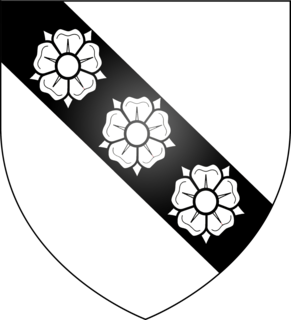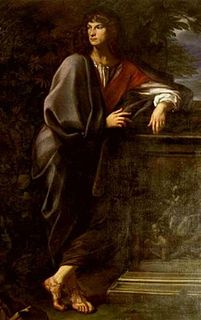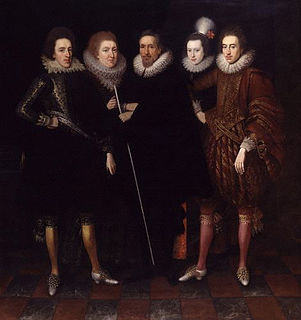
Earl of Longford is a title that has been created twice in the Peerage of Ireland.

Marquess of Huntly is a title in the Peerage of Scotland created on 17 April 1599 for George Gordon, 6th Earl of Huntly. It is the oldest existing marquessate in Scotland, and the second-oldest in the British Isles, only the English marquessate of Winchester being older. The Marquess holds the following subsidiary titles: Lord Gordon of Strathaven and Glenlivet and Earl of Aboyne, and Baron Meldrum, of Morven in the County of Aberdeen

Viscount Hereford is the oldest and only extant viscountcy in the Peerage of England, making the holder the Premier Viscount of England. The title was created in 1550 for Walter Devereux, 10th Baron Ferrers of Chartley.

Earl of Coventry is a title that has been created twice in the Peerage of England. The first creation for the Villiers family was created in 1623 and took its name from the city of Coventry. It became extinct in 1687. A decade later, the second creation was for the Coventry family and is still extant.

Earl of the Island of Jersey, usually shortened to Earl of Jersey, is a title in the Peerage of England held by a branch of the Villiers family, which since 1819 has been the Child-Villiers family.

Earl of Kingston is a title in the Peerage of Ireland. It was created in 1768 for Edward King, 1st Viscount Kingston. The Earl holds the subsidiary titles Baron Kingston, of Rockingham in the County of Roscommon, Viscount Kingston, of Kingsborough in the County of Sligo, Baron Erris, of Boyle in the County of Roscommon, and Viscount Lorton, of Boyle in the County of Roscommon, also in the Peerage of Ireland. He is also a baronet in the Baronetage of Ireland. Between 1821 and 1869 the earls also held the title Baron Kingston, of Mitchelstown in the County of Cork, in the Peerage of the United Kingdom.

Earl of Craven, in the County of York, is a title that has been created twice, once in the Peerage of England and once in the Peerage of the United Kingdom.

Earl of Powis (Powys) is a title that has been created three times. The first creation came in the Peerage of England in 1674 in favour of William Herbert, 3rd Baron Powis, a descendant of William Herbert, 1st Earl of Pembroke. In 1687, he was further honoured when he was made Marquess of Powis.

Earl of Drogheda is a title in the Peerage of Ireland. It was created in 1661 for The 3rd Viscount Moore.

Earl of Donoughmore is a title in the Peerage of Ireland. It is associated with the Hely-Hutchinson family. Paternally of Gaelic Irish descent with the original name of Ó hÉalaighthe, their ancestors had long lived in the County Cork area as allies of the Mac Cárthaigh clan; they lost out during the times of Oliver Cromwell. One branch of the family converted to the Anglican Church and after inheriting territories through his mother and adding "Hutchinson" to Hely, became the Earl of Donoughmore.

Earl of Plymouth is a title that has been created three times: twice in the Peerage of England and once in the Peerage of the United Kingdom.

Earl of Strafford is a title that has been created three times in English and British history.

Baron Hunsdon is a title that has been created three times.

Earl of Sunderland is a title that has been created twice in the Peerage of England. The first creation came in 1627 in favour of Emanuel Scrope, 11th Baron Scrope of Bolton. The earldom became extinct on his death in 1630 while the barony became either extinct or dormant. The second creation came in 1643 in favour of the Royalist soldier Henry Spencer, 3rd Baron Spencer of Wormleighton. The Spencer family descended from Sir John Spencer who acquired the Wormleighton estate in Warwickshire and the Althorp estate in Northamptonshire. His grandson Sir John Spencer was a Knight of the Shire for Northamptonshire. The latter's grandson Sir Robert Spencer represented Brackley in Parliament in the late 16th century. In 1603 Sir Robert was raised to the Peerage of England as Baron Spencer of Wormleighton. He was succeeded by his eldest surviving son, William, the second Baron. He had previously represented Northamptonshire in Parliament. His eldest son was the aforementioned third Baron. In July 1643 he was created Earl of Sunderland in the Peerage of England. Lord Sunderland was killed at the Battle of Newbury in September of the same year. He was succeeded by his two-year-old only son, Robert, the second Earl. He later gained great distinction as a statesman and notably served four times as Secretary of State for the Southern Department.

Earl of Monmouth was a title that was created twice in the Peerage of England. The title was first created for English courtier Robert Carey, 1st Baron Carey in 1626. He had already been created Baron Carey, of Leppington, in 1622, also in the Peerage of England. The titles became extinct upon the death of his son, the second Earl, who died without surviving male issue in 1661. The second creation, in 1689, was for the great-grandson of the first Earl of the first creation, Charles Mordaunt, 2nd Viscount Mordaunt. In 1697 he succeeded his uncle as Earl of Peterborough. See the latter title for more information.

Charles Mordaunt, 3rd Earl of Peterborough and 1st Earl of Monmouth, was an English nobleman and military leader. He was the son of John Mordaunt, 1st Viscount Mordaunt, and his wife Elizabeth, the daughter and sole heiress of Thomas Carey, the second son of Robert Carey, 1st Earl of Monmouth. Mordaunt's father, John Mordaunt, was created Viscount Mordaunt of Avalon and Baron Mordaunt of Reigate, Surrey, in 1659.
The title Baron Mordaunt was created in 1529 for Sir John Mordaunt. The fifth baron was created Earl of Peterborough in 1628 and the title then passed to his son, the second earl, in 1644. On his death in 1697, the earldom was inherited by his nephew, Charles and the barony was inherited by his only child, Mary, the estranged wife of the 7th Duke of Norfolk. When she died childless in 1705, the barony was also inherited by Charles, who had also been created Earl of Monmouth. On the death of the 5th Earl of Peterborough in 1814, the title passed to his elder half-sister, Mary. When she died childless in 1819, the title then passed to the 4th Duke of Gordon, who was a maternal great-grandson of the 3rd Earl of Peterborough. The title was then inherited by the 5th Duke of Gordon in 1827 and when he died without legitimate issue in 1836, the title became abeyant between his sisters and their issue.

Baron Wentworth is a title in the Peerage of England. It was created in 1529 for Thomas Wentworth, who was also de jure sixth Baron le Despencer of the 1387 creation. The title was created by writ, which means that it can descend via female lines.

John Mordaunt, 1st Viscount Mordaunt was an English royalist.
Charles Mordaunt, 4th Earl of Peterborough, 2nd Earl of Monmouth was a British peer and Member of Parliament, styled Viscount Mordaunt from 1710 to 1735.











